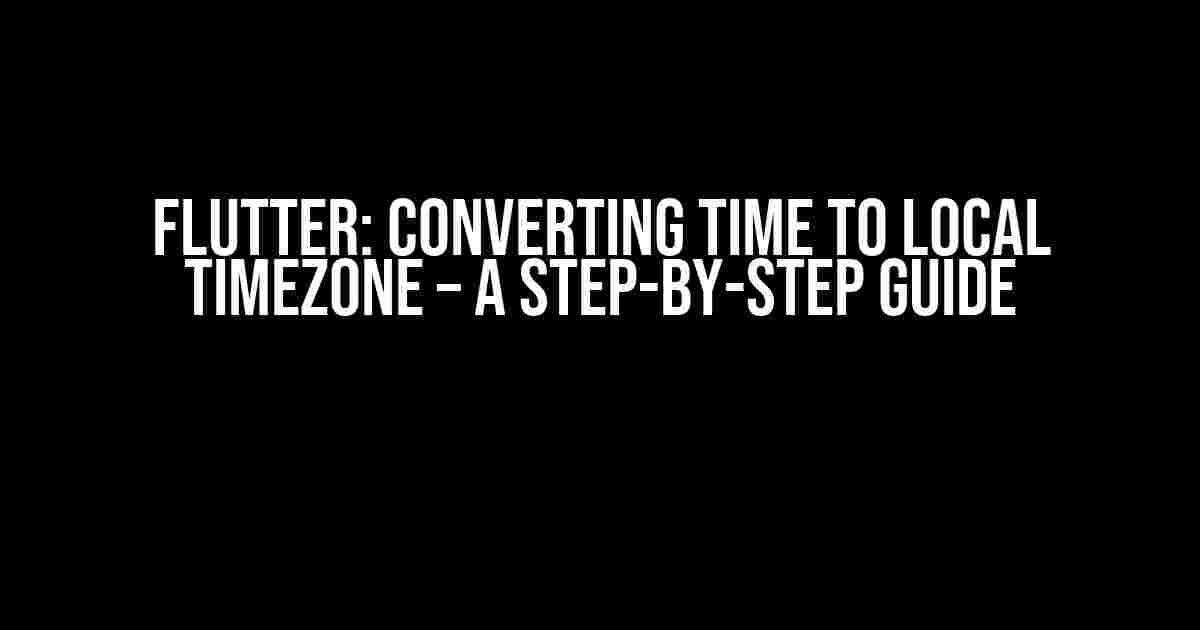Are you tired of displaying timestamps in UTC and wanting to show the local time to your users? Look no further! In this article, we’ll take you on a journey to convert time to the local timezone in Flutter. By the end of this tutorial, you’ll be a master of time conversions and impress your users with a more personalized experience.
Why Convert Time to Local Timezone?
Showing timestamps in UTC can be confusing for users, especially when they’re in different timezones. Converting time to the local timezone ensures that your app displays the correct time, taking into account daylight saving time (DST) and other regional variations. This is particularly important for apps that deal with scheduling, events, or any time-sensitive information.
Flutter’s DateTime Class
Before we dive into the conversion process, let’s familiarize ourselves with Flutter’s `DateTime` class. This class represents a specific moment in time, including the date, hour, minute, second, and millisecond.
DateTime now = DateTime.now();
print(now); // 2023-03-15 14:30:00.000
The `DateTime.now()` method returns the current UTC time.
Converting UTC to Local Timezone
Now that we have the UTC time, let’s convert it to the local timezone using the `timezone` package. Add the following dependency to your `pubspec.yaml` file:
dependencies:
flutter:
sdk: flutter
timezone: ^0.8.0
Then, import the package in your Dart file:
import 'package:timezone/timezone.dart' as tz;
Get the local timezone using the `tz.getLocation()` method:
Future<tz.Location> getLocation() async {
final String locationId = 'America/New_York'; // Replace with your desired location
final tz.Location location = await tz.getLocation(locationId);
return location;
}
Now, convert the UTC time to the local timezone using the `tz.TZDateTime.from()` method:
Future<void> convertUtcToLocal() async {
final tz.Location location = await getLocation();
final DateTime utcTime = DateTime.now().toUtc();
final tz.TZDateTime localTime = tz.TZDateTime.from(utcTime, location);
print(localTime); // 2023-03-15 10:30:00.000 (EDT)
}
In this example, we’re converting the current UTC time to the Eastern Daylight Time (EDT) timezone.
Handling Daylight Saving Time (DST)
DST can be a bit tricky, but the `timezone` package has got you covered. When converting UTC to local time, the package takes into account DST rules for the specified location.
Let’s modify the previous example to demonstrate DST handling:
Future<void> convertUtcToLocalWithDst() async {
final tz.Location location = await getLocation();
final DateTime utcTime = DateTime.parse('2023-03-12 12:00:00.000Z'); // UTC time before DST
final tz.TZDateTime localTimeBeforeDst = tz.TZDateTime.from(utcTime, location);
print(localTimeBeforeDst); // 2023-03-12 07:00:00.000 (EST)
utcTime = DateTime.parse('2023-03-19 12:00:00.000Z'); // UTC time after DST
final tz.TZDateTime localTimeAfterDst = tz.TZDateTime.from(utcTime, location);
print(localTimeAfterDst); // 2023-03-19 08:00:00.000 (EDT)
}
In this example, we’re converting the same UTC time to the local timezone before and after DST. The package correctly applies the DST rules, resulting in different local times.
Common Timezone Locations
Here are some common timezone locations you can use:
| Location | Timezone ID |
|---|---|
| New York | America/New_York |
| Los Angeles | America/Los_Angeles |
| London | Europe/London |
| Paris | Europe/Paris |
| Tokyo | Asia/Tokyo |
| Sydney | Australia/Sydney |
Conclusion
Converting time to the local timezone in Flutter is a breeze with the `timezone` package. By following this guide, you’ve learned how to:
- Get the local timezone using the `tz.getLocation()` method
- Convert UTC time to the local timezone using the `tz.TZDateTime.from()` method
Remember to replace the location ID with the desired timezone for your app. With this knowledge, you’ll be able to provide a more personalized experience for your users, displaying the correct local time and taking into account DST variations.
Happy coding, and don’t forget to set your clocks correctly!
Here are 5 Questions and Answers about “Flutter converting time to local” with a creative voice and tone:
Frequently Asked Question
Got questions about converting time to local in Flutter? We’ve got answers!
How do I convert UTC time to local time in Flutter?
You can use the `DateTime` class in Flutter to convert UTC time to local time. Simply create a new `DateTime` object with the UTC time, and then call the `toLocal()` method to convert it to the user’s local time zone.
What is the best way to handle daylight saving time (DST) when converting time to local in Flutter?
To handle DST, you can use the `TimeZone` class in Flutter to get the current time zone offset, and then apply it to your converted time. This will ensure that your app takes into account DST changes when converting time to local.
Can I use a third-party package to convert time to local in Flutter?
Yes, there are several third-party packages available that can help with converting time to local in Flutter, such as `jiffy` or `timezone`. These packages provide additional functionality and flexibility when working with dates and times in Flutter.
How do I format the local time in Flutter to display in a specific format?
You can use the `DateFormat` class in Flutter to format the local time in a specific format. For example, you can use `DateFormat.yMd()` to display the date in the format `yyyy-mm-dd`, or `DateFormat.jm()` to display the time in the format `hh:mm a`.
What if I need to convert time to local in a specific locale or language in Flutter?
You can use the `intl` package in Flutter to provide localized date and time formatting. This package allows you to specify the locale and language, and then use the `DateFormat` class to format the local time accordingly.
